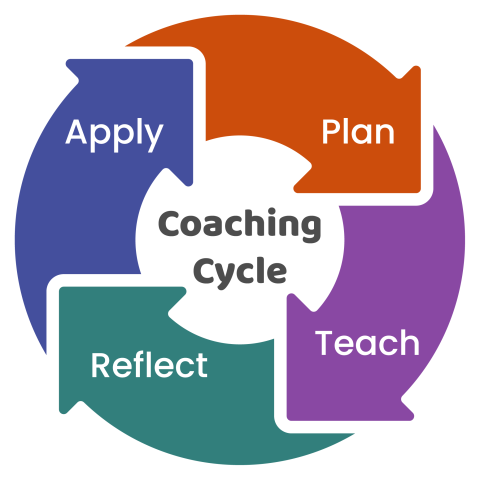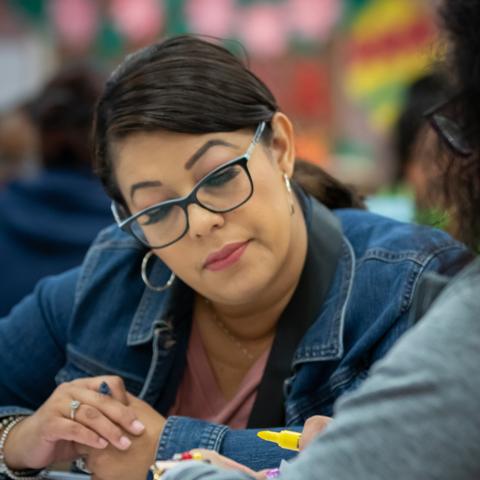Facilitator Resources
Building The Capacity Of Educators
Suites of resources on a range of early STEAM topics for facilitators and coaches to use in professional learning with educators.
A coaching cycle is a process in which a coach and coachee work together to set goals, make plans, and reflect on how their plan went. Many different approaches can make up a coaching cycle. However, a coaching cycle generally includes four parts: plan, teach, reflect, and apply.
Let’s explore each part of a coaching cycle.

During the planning phase, the coach and coachee develop a collaborative learning partnership. They learn about each other, build a relationship, establish expectations, and discuss goals and desired outcomes.
They might record their goals and plan for achieving them in an action plan or coaching agreement. As coaches and coachees work together, they continually review and update their goals and plan as needed.
Use this General Coaching Conversation Template during meetings with coachees as you discuss their goals and next steps.
Next, the coach and coachee work together to engage children in a math learning experience. They might use one or more of the following practices: observation, co-teaching, or modeling. Each practice involves a different level of scaffolding, or support, provided by the coach.
A coach might observe a coachee facilitating a learning experience. As they observe, the coach records what they notice using objective, data-based language.
For example, instead of “the lesson was engaging,” an objective observation might be “Children were observing the book illustrations while the educator was reading.”
A data-based observation is, for example, when a coach says, “During this lesson, you asked nine closed questions, two open-ended questions, and six rhetorical questions.”
Use this Observation Note-Taking Template to record your observations of an educator engaging children in early math learning experiences.
Co-teaching may involve a coach and coachee facilitating a learning experience together.
For example, the coach may facilitate parts of the learning experience while the coachee is responsible for other parts of the learning experience.
Or the coachee might facilitate the whole learning experience while the coach offers additional facilitation in the moment to support the coachee’s growth.
A coach might model ways to facilitate a learning experience while the coachee observes. This method helps coachees learn new teaching strategies to use with children.
Coaches should demonstrate authentic, flexible, and messy learning experiences so that coachees can benefit from observing realistic examples. For example, when planning a lesson, coaches should use a similar amount of time as educators would to plan and prepare for the lesson.
Provide this Demonstration Note-Taking Template for your coachee to record their observations during a demonstration lesson.
After facilitating a math learning experience, the coach and coachee discuss and reflect. During this reflection, the coach creates a safe space for collaborative reflection and decision-making. Topics for their reflection might include:
Toward the end of their debrief, the coach and coachee may make plans for future coaching sessions. Defining actionable next steps helps maintain the coach–coachee relationship. This process also shows that the coach is committed to supporting coachees over time.
For additional resources on ways to reflect on children’s early math learning experiences, visit the M5 Early Math Approach suite of resources.
The coachee can apply what they learned from this coaching cycle in different ways. For example, they may incorporate the feedback immediately into their next math learning experience. They may update their goals so that the coach and coachee can continue to meet regularly and track the coachee’s progress over time.
We have explored each part of the coaching cycle. Next, let’s observe the coaching cycle in action through two sets of video examples.
The first set of examples features Jon, an early math coach from Count Play Explore, and Ismerai, a first-grade educator. Jon and Ismerai had been working together (along with other early educators at the school) for about a year before filming.
The second set of examples features Millie, an early math coach, and Sara, an early childhood educator working with toddlers who are 24–36 months old. Sara shared that she was a new toddler teacher and had worked with preschoolers before. Millie had previously worked with other educators at the center. This was the first time she had worked with Sara.
Observe the video examples that best match your role and learning setting. After observing the videos, reflect on the questions provided. Consider sharing these video examples with coachees to illustrate the various components of a coaching cycle.
Observe this video of coach Millie and educator Sara discussing their plan for an outdoor activity with toddlers. Notice how Millie and Sara use the M5 Early Math Approach as a framework to guide Millie’s observation. To learn more, visit the M5 Early Math Approach suite of resources.
Reflect:
Observe this video of educator Sara engaging with toddlers in the outdoor activity while coach Millie observes. Consider how Sara and Millie interact with the children to support their early math learning.
Reflect:
Observe this video of coach Millie and educator Sara reflecting and debriefing on the activity. Notice ways the coach and coachee communicate with each other—verbally and nonverbally—during their coaching conversation and continue to build rapport.
Reflect:
Observe this video of coach Millie and educator Sara discussing new strategies that Sara can incorporate into her early math teaching practice. Notice how Millie and Sara work together to identify these new strategies based on their joint observations and reflections.
Reflect:
Observe this video of coach Jon and educator Ismerai discussing their plan for a geometry lesson. Notice how Jon and Ismerai share ideas and build their coaching relationship. Consider the materials they use during this coaching conversation.
Reflect:
Observe this video of coach Jon modeling a geometry lesson while educator Ismerai observes. Then, Jon and Ismerai co-teach the second part of the lesson. Consider how Jon uses modeling and co-teaching (coaching practices) to support Ismerai.
Reflect:
Observe this video of coach Jon and educator Ismerai reflecting and debriefing on the lesson. Notice ways the coach and coachee communicate with each other—verbally and nonverbally—during their coaching conversation and continue to build rapport.
Reflect:
Review Jon’s written reflection of his coaching session with Ismerai. Consider what Jon and Ismerai might have learned from this coaching session and what they will do next.
Reflect:
Let’s reflect on the coaching cycle. Consider the following questions:
Reflect:
Reflect on the four parts of the coaching cycle: plan, teach, reflect, and apply.

Modules for leaders, professional learning facilitators, and coaches to build their knowledge and skills in how to provide early STEAM professional learning.
Suites of resources on a range of early STEAM topics for facilitators and coaches to use in professional learning with educators.
Copy the link below to share this resource with students, families and colleagues, or to save for later.